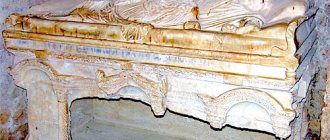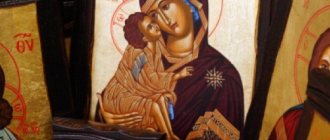The home of not a single Orthodox family is complete without icons; it is a mediator between us and the saints. Prayer in front of an icon is stronger because we have a visual image of the person we are addressing, which helps us concentrate a lot. Icon painting has been known for thousands of years, and during this time a huge number of icons have appeared, but they cannot exist in an unnamed state forever. If the image is badly damaged, we cannot read the face of the saint on it; of course, its owners may want to get rid of the icon. The only rule that needs to be remembered forever is that icons cannot be thrown away like ordinary garbage.
What to do with an old icon?
Dilapidated, old icons should be taken to the temple. If the image has completely lost its appearance, it will be burned in a church oven. You can burn them yourself, but not together with the garbage, but separately, clean. An icon always remains an icon, no matter what deplorable state it is in. An icon that is slightly faded or has minor damage can also be taken to the church, perhaps one of the parishioners will take it. Not far from the entrance to the temple there is usually a memorial table, where parishioners bring food to honor the memory of the deceased. The icon can be left on the funeral table; it would also be good to bring food, thereby expressing love for your deceased relatives. An unwanted image can be given to a church shop. You should not give someone an icon in poor condition, it will be disrespectful.
Very old icons can be restored, sometimes this turns out to be more profitable from an economic point of view than buying a new one.
After all, an image is often a family heirloom, passed down from generation to generation, and losing it is simply unbearable for family members.
Stages of work
The cleaning and washing process should be handled with care so as not to cause harm. Simple cleaning, washing or restoration of icons requires a special reverent attitude towards the process. The work is done slowly and carefully, since one wrong movement can irrevocably destroy the image of the holy face. In most cases, icons are washed using a soap solution made from baby soap. For this purpose the following events are carried out:
- Using a cotton swab slightly moistened in a soap solution, wipe the surface of the icon.
- After this, the remaining liquid is removed with cotton wool.
- If the contamination is convex in nature, it can be easily removed with a scalpel.
- Residues from such contamination are also removed with a soap solution.
Copper frames require special treatment. To clean them, they most often use special products for jewelry or wash them with tooth powder. This process must be carried out carefully, as such substances can damage the integrity of the coating. The shrine requires special treatment, so it is better to entrust the cleaning of heavy dirt or image restoration to an experienced specialist who can evaluate the quality of the paint coating and uses special cleaning products. A timely contact with a restorer will prevent the possibility of damage to the holy face.
Icons of the former owners of the house
It often happens that when buying a house or apartment, new residents discover abandoned icons. In this case, as in any other, you cannot throw away the icons of the old owners. An icon is a shrine and must be treated with respect. There is nothing wrong with leaving them. But if you are in doubt because of the unknown history of their presence in the house, the icons can be re-consecrated.
In family houses, icons that belonged to deceased relatives are usually kept, which the young people do not want to leave behind. Again, new icons from your home can be taken to the temple or donated if the images have retained their appearance. Many people mistakenly believe that giving and accepting images from someone else’s hands is prohibited, but the church believes that giving them as a gift is a good tradition. The icon cannot harm you, since it is a sacred object. If you doubt its former owners, you can bring it to the temple and ask for it to be consecrated.
Is it possible to sleep on the bed or sofa of a deceased relative?
Is it possible to sleep on the bed of a deceased relative?
- There is an expression: “It is better to sleep on the grave of a dead person than on his bed!” Perhaps there is some truth in this. If a person was sick for a long time, experienced crazy torment on the bed, and eventually died on it, then it is of course better to part with such an inheritance
- People related to extrasensory perception argue that it is better to replace the bed of a deceased person. If it is not possible to buy a new bed, but you need to sleep on something, then it is better to perform a ritual of cleansing the deathbed of a loved one. To do this, you can go around the bed on all sides with a lit church candle, passing it over and under it, sprinkle it with holy water and sprinkle with salt.
- If the deceased person had some otherworldly abilities, then to get rid of the trace of his strong energy, it is better to invite a clergyman to the house. The church, as a rule, meets its parishioners halfway and helps them overcome their fears of the unknown
- If you turn with similar thoughts to someone more down-to-earth, such as scientists or doctors who are skeptical about this kind of activity, they are unlikely to find anything reprehensible in keeping the sofa or bed of a deceased person for themselves. Their only advice may be to disinfect furniture or reupholster it. This is especially true for those options when a person died from an infectious disease or virus
What to do with the bed of a deceased relative?
- The Church, in turn, may take a reprehensible attitude towards the desire of relatives to keep the deathbed of their loved one. It is not Christian to sleep on a bed where another person has come face to face with death.
- The psychological side of this issue is also very important. A person who has lost a loved one may not immediately be able to get rid of grief and melancholy. An object associated with this person can often remind you of him and excite sad thoughts in your head
- However, there is a category of people for whom, on the contrary, memorabilia gives only positive emotions and memories. Falling asleep on the bed of their relative, they can meet them more often in their dreams and enjoy such spiritual communication
- In other words, the choice is yours. If you are able to subjugate your feelings of fear and give up superstitions, then put the bed of your loved one in order and sleep on it to your health!
We advise you to study Prayers for unborn children
Icons that belonged to strangers
Sometimes old wedding couples remain in houses, icons that are given to the newlyweds during the wedding sacrament, or icons of guardian angels of deceased relatives or old owners of the house. You can keep such images for yourself. An icon is not a talisman; people pray to a saint in front of it, and therefore it doesn’t matter at all who previously owned the shrine and for what reason it appeared among the previous owners. The wedding couple usually consists of the icon of Jesus Christ “Lord Pantocrator” and the Mother of God – “Kazan Mother of God”. These images of saints can move from couple to couple or even end up with a single person, this is acceptable.
An icon is a symbol of faith. Unlike modern paintings, holy images carry an instructive meaning. Each icon is a work of art, with its own history and intention. Many icons very reliably convey the events described in the Gospel, scenes from which are very often used by icon painters. Therefore, they should be treated with respect and awe, and not as a piece of furniture. And even if you decide to say goodbye to the old icon, you need to do this according to the rules, so as not to offend the saint whose face is depicted on the icon, and not to harm yourself through reprehensible actions.
( 5 ratings, average: 4.40 out of 5)
Is it possible to give your cross to another person?
Here the answer is clear: it is possible, and sometimes necessary, if another person needs God’s protection, but does not have a cross.
This is a very plausible act, especially if it is done from a pure heart, at the behest of the soul, and not to atone for one’s sins. A mother or father can give a cross to their child - this is also not prohibited by the church. If deeply religious parents decide to give a cross to their son or daughter, they thereby share their own wisdom and piety with their children. And if the parents are not too strong in faith, the children will simply receive a consecrated vessel, which they themselves will have to fill with spiritual content. So there will be no harm from this either.
Children are also not forbidden to pass on their own shrines to their parents. Let's say a father is undergoing a complex operation or an elderly mother suffers from a severe form of dementia - don't parents need the support of their children and God?
There is a superstition among not very enlightened Christians: giving your cross to another person means sharing with him your own destiny, which was destined from the very beginning. Therefore, many are afraid to wear someone else’s cross because through it they supposedly accept all the hardships and illnesses of the previous owner.
Children's crosses in the Sunlight catalog
This is a dense, but very tenacious bobcat. The Christian Church denies the existence of blind fate and generational destiny in principle. According to its principles, each person creates his own destiny: he is free to both sin and lead a righteous life, but each of his actions will subsequently be assessed by the highest Judge, that is, God.
If an Orthodox clergyman dies, the religious objects belonging to him are distributed to other priests. This also applies to crosses, both body and pectoral, that is, worn “on the chest” (on the chest) over the robe during services and rituals. The heirs of the deceased wear the crosses of the deceased with the highest favor. So wearing other people’s crosses and accepting symbols of faith as gifts can and should be done.
How to get rid of sacred things
Things that were used to perform rituals and sacraments are not thrown away with ordinary garbage. They are burned or buried in a special place. In a flower garden, in a field where no one tramples underfoot.
Religious items that have been accumulated at home over the years are not mixed with household waste.
Recommendations from priests:
- Use spoiled oil for lamps that glow near the home iconostasis.
- Drink holy water, not store it. If the water has spoiled, pour it onto the ground, which is not trampled under foot.
- Do not collect the prosphora, but eat it on time. If it happens that they are no longer suitable for food, bury them in a secluded place where people do not go.
- Store willow branches at home and burn them later.
- Deliver broken crosses and broken lamps to the church. The church workers will figure out what to do.
If there are a lot of calendars and magazines with Christian themes accumulated at home, then they are not thrown away with waste. Reproductions with the faces of saints can be cut out and framed in a frame. Consecrate the prepared icon and use it for its intended purpose.
It would be more prudent to distribute church literature to those in need:
- donate to orphanages;
- houses for elderly people;
- prisoners.
In all problematic cases, it would be correct to give old books to the temple for restoration or disposal.
You can restore a printed publication yourself. Especially if the copy is valuable. Books that were printed before the mid-twentieth century are worth preserving. In the modern world, the respectful attitude towards people, and even more so towards holy icons, is gradually being lost. The force of habit and impunity is at work. But every person must take matters of faith responsibly. After all, it’s not at all difficult to adhere to accepted standards.
Is it possible and how to throw away icons, church candles, and stubs of church candles?
The clergy argue that everything connected with God and the saints should under no circumstances be thrown into the trash. In general, in any church there is a collection point for old things that must be brought there. Usually, all these old products that cannot be restored are of no value; they are simply burned in special ovens, and the ashes are buried in the garden as fertilizer.
Rules for throwing away consecrated items:
- In principle, you can do the same if you have some old icons. They do the same with old Bibles, various books, with religious content. They also need to be burned and the ashes buried in the garden.
- The situation is different with the remains of candles. The fact is that every church has a certain norm of leftovers, which it must hand over to the main receiver.
- Therefore, if you have any leftover wax from a burnt candle that you purchased at church, you can bring it to church. They can also be burned or melted down. By the way, this is what they do in churches. Everything that is not burned and remains after the liturgy or service is collected and melted down for the cheapest church candles. There's nothing wrong with that.
Icon
Why does he disappear from home according to signs?
When a holy image disappears from a house for one reason or another, this means that the home loses protection from evil spirits. The event itself is unpleasant and requires certain actions from the owner of the house. Since the icon was stolen or taken secretly for some unseemly deeds, then all the negativity will go to the culprit.
And the owner of the house, regardless of whether there is a shrine or not, needs to consecrate his home. To do this, you can invite a priest or do it yourself. You will need to go around the entire house with a lit church candle and sprinkle every corner with holy water.
The consecrated symbol of faith requires careful and respectful treatment. In situations where a person does not know what to do, he should seek advice from a clergyman. Signs relating to icons were created by ordinary people. And a person serving in the temple of God interprets these concepts from the point of view of the Orthodox faith.
Source of the article: https://tfu-tfu.ru/primety/predmety/ikony











